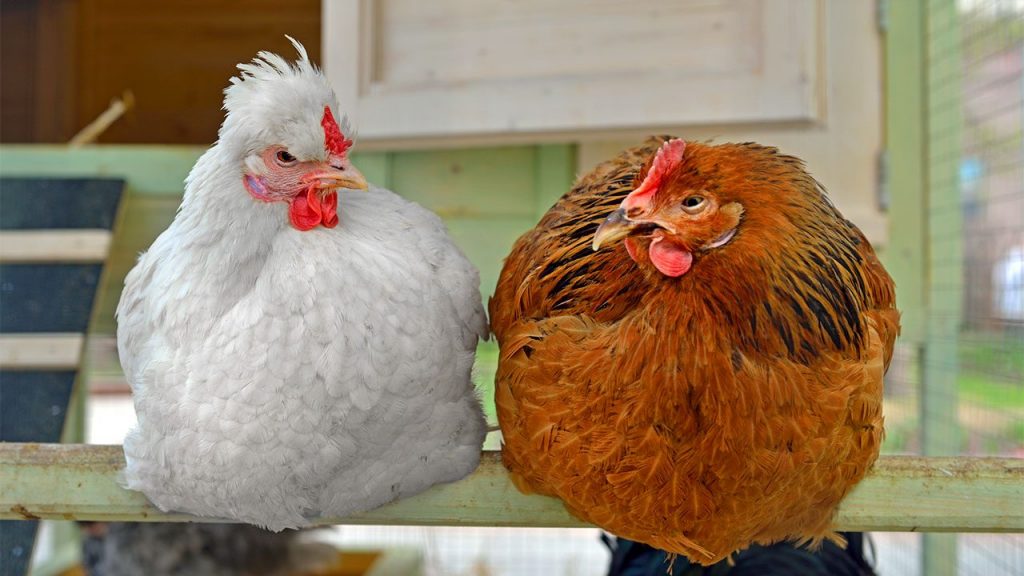Blog Post
A few simple reasons that you should get chickens
By Jonathon Van Maren
One of my earliest memories is the realization that chickens are people, too.
When I was still small, my dad set up a chicken coop in our backyard, built a pen, and headed off to various livestock auctions and hatcheries to start building our flock. We had wispy white silkies, crown-crested Polish chickens, foot-feathered Cochins, and all sorts of miniature Bantams, which were the perfect size for children.
Every morning before school, I lugged buckets of water and feed out to the coop; every afternoon after school, we all bolted for the poultry pen (which also featured a few ornery pygmy goats, some ducks, and whatever else we could wheedle Dad into purchasing.) They came running out to meet us, crooning and clucking in anticipation of the bread we’d bring them.
They all had names. Number Ten Hen was my brother’s chicken, a little black Bantam with a #10 auction band around her foot. Her sister, Small Hen, was mine, and she would croon sweetly when we stroked her feathers until they were shiny from our sweaty hands. Orange Rooster, another unfortunate recipient of our naming creativity, gleamed the color of Anne of Green Gables’ hair and spent much of his time preening for the Bantam sisters.
We had a long-legged Bantam rooster named Colman, after Billy Colman of Where the Red Fern Grows, and his wife, Long-Legged Hen (yes, I now realize that my parents must have found this all hysterical.) Goat Rooster was a little chick that got bullied by the other chickens and finally abandoned the coop to live in the calf hutch with Marigold and Snowball, the goats who frequently birthed kids the size of tiny kittens.
Fowl personalities
Chickens are all very curious and covetous creatures. They can be pecking lustily at leftover cake or croissants, but if you toss a rock across the pasture, they will abandon their meal in an instant and go streaking after the pebble, determined to be the first one to secure the prize. They are also very envious and will abandon a large piece of bread for a much smaller one that their friend is gobbling because she looks to be enjoying herself so much.
My favorite is always the broody mothers, who ruffle themselves over their eggs, glaring furiously if you venture too closely. I’ve seen baby chicks hatch dozens of times, and it awesome every time—the cracks; the little tooth on the tiny beak hammering away; the peeping from within the shell as the mother keeps anxious watch; the egg finally giving away, emptying the little bird into the world to join his peeping siblings and his beady-eyed mom, angrily pecking anyone who gets too close.
The roosters, like all males, are preening, prideful, and perpetually picking fights. Bantam roosters grow wicked spurs, and mating rituals will often be interrupted by furious fights, the suitors leaping into the air and lashing out with their spiked legs. If a blow strikes home, a spur can easily tear a wattle or a comb or even pierce feathers and draw blood. The victor gets to gaspily limp off to present himself to the unimpressed ladies, who don’t so much resist the advances of the roosters as endure them with scornful and unruffled dignity.

My big black Barnavelder, who has achieved the nickname Harvey (Weinstein) due to his habit of stealthily pouncing on his victims while they eat, spends nearly all of his time hopping from hen to hen. His harem responds by ignoring his presence almost entirely. One hen interrupted the proceedings by merely looking around with what appeared to be insulting bemusement.
Each morning, I head out to the coop with my three-year-old, who races ahead of me to search for the first eggs (after being frequently awakened by the “cock-a-doos,” which she resolutely refuses to refer to as roosters.) “Morning, chickens!” she announces as she flings open the door. If the eggs are freshly laid, she’ll immediately hold them to her cheek to see if they’re still warm, a huge smile spreading across her face if they are. One poor hen, after successfully pushing out an egg, ruffled her feathers to let out her victory cluck—and widened her eyes in shock when a little hand shot underneath her, and Charlotte snatched the fruit of her labor, pressing it to her cheek. Well I never, the hen squawked, stomping out of the coop.
I have other birds, too, but the chickens are her favorite. The pheasants—red, golden, and ring-necked—are more regal but too jumpy. The bob white quail sings beautifully but cannot be cuddled. The Chukar partridge, whose wicked beak needs to be trimmed every few weeks, in all likelihood wishes to kill us, but is too small to pull it off. And so it is the chickens, with their beautiful, burnt-orange eyes and their soothing croons, that have won her love.
The chicken wars
A key part of owning chickens is defending them from predators.
In British Columbia’s Fraser Valley, that meant a long war with the droves of rats who seemed to materialize out of nowhere at the presence of vulnerable poultry. They burrowed under our wooden chicken coop and raised large, fat families on the chicken feed and the birds themselves, often with grotesque results. They would scale the walls of the coop to the nesting boxes where our pigeons hatched their young and eat the babies in the nests, leaving the murdered remains. Frequently, they would make hunting forays into the coop at night, and we would find the mutilated bodies of favorite pets the following morning. This is not fun for an adult—for a child, it is downright traumatizing.
Rats are shockingly versatile vermin, hard to kill because they are so clever. We shoved bars of rat poison into their holes, pushing them in with sticks so the chickens didn’t eat them (the pellets were an appetizing turquoise blue that birds were immediately drawn to.) The poison had limited effect, as after a rat or two died horribly, their relatives collectively decided to stick to chicken dinners. Dad offered me two dollars for every rat I managed to kill, so I spent hours lying in the long grass near the chicken coop, aiming at one of the burrows. The problem with my pellet gun was that it wasn’t very powerful. To kill a rat, I had to hit it directly in the head—if I winged one, it would leap into the air with a little screech and scurry off.
Even headshots were not always immediately effective. After shooting one twice, I ran over to pick it up by the tail, and as I admired it, the vile thing began leaping in my hand. I flung it down in panic, stomped on it, and shot it through the eyes. Another enormous rat—a sinister fellow over a foot long who had fattened himself on our pets—proved even tougher. Rats, like crows, figure out patterns very quickly, and so they soon recognized my gun, or spotted me in an attempted ambush.
To mix things up, I had to slide the barrel through a large knothole in the wall of the coop and wait for nearly an hour until the big fellow heaved himself through the chicken door and sat up, sniffing suspiciously. He saw the barrel and froze, and then leaned forward to examine it. When I pulled the trigger, he nearly flipped over backwards. It took five shots to finish him off.
In Oxford County, Ontario where I live now, the key threats to chickens are weasels, raccoons, and, as I discovered, hawks. I should have figured this out early on, as a friend and I were building my new chicken pen this spring, a hawk dropped out of the sky like an earth-bound bullet, reducing a pigeon that had been pecking the grass near us to a smear of feathers, and pulled back up into the blue as fast as it had come. I made sure my coop doors were shut and latched every night to keep out any rodents, but one day, a Cooper’s hawk discovered us. Heading out to dump a bucket of leftovers to the chickens, I noticed they were clucking nervously and huddled around the doors. Around the corner, a hawk was perched on one of my hens, finishing off the last of his meal. It flapped off in a fury when I interrupted. A few hours later, he was back, perched on my gatepost, eyes fixed on the door, waiting for the second course to wander out.
Cooper’s hawks are known to be tough customers and can even dive through flimsy chicken wire if motivated enough. But this one was particularly ingenious. After a few days, he appeared to be sick of waiting for me to let the chickens out and had abandoned his lookout in the neighbor’s tree. I let them out again, and all seemed to be well. Then, I noticed that one of my hens appeared to be missing and walked out to take a look. Not seeing her anywhere, I laid down to check under the coop, which is raised slightly off the ground. Peering back at me was the hawk, who had crawled under the coop, killed my hen, and was just about to enjoy a meal. With a flurry of feathers and panicked scrabbling, the hawk pushed himself out the other side and winged off. Too late for my hen, who’d lost her head.
Get Chickens
The good news is that chickens are worth defending. They are interesting, humorous, and filled with character. They will follow you like a dog and come when you call. If you treat them well, they will reward you with fat, brown eggs. If you get there on time, some of them will still be warm.
There is only one exception to this. I purchased a few white meat chickens for food when I got my Barred Rock and Rhode Island Red layers. As they grew up, I discovered that they are genetically modified to never feel satiated. They lay gasping around the feeder in the summer heat, fat, uncomfortable, and yet still eating. They looked so miserable I will never raise them again. Their chickenness had been bred right out of them, and they were sad, breathing cutlets. The contrast to their bright-eyed cousins scurrying after dragonflies and bugs in the grass was almost unbelievable.
I’ll stick with real chickens from now on.
In short: Get chickens, even if you only have room for a few. Get to know them. Watch them. Teach your kids to feed them. You won’t regret it.








